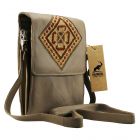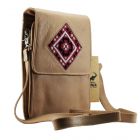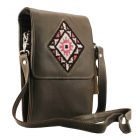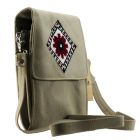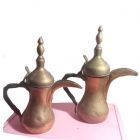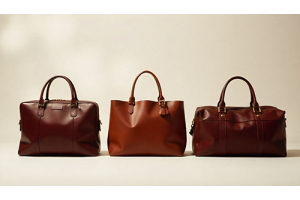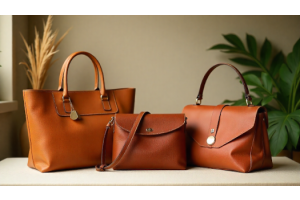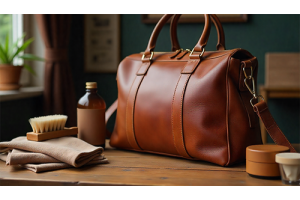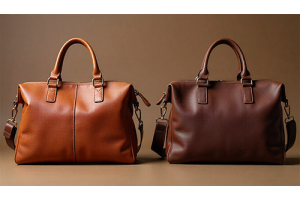Leather Bags: A Durable and Eco-Friendly Choice
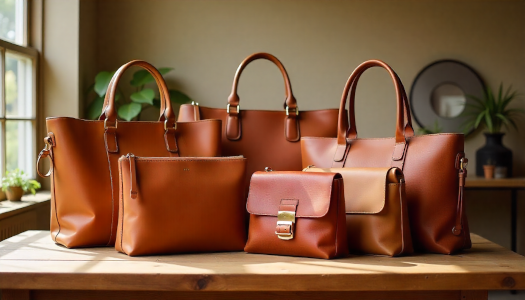
Leather Bags: A Durable and Eco-Friendly Choice
Leather bags are more than just a fashion statement—they are a smart, sustainable investment. Unlike fast-fashion alternatives, high-quality leather bags are designed to last for years, reducing the need for frequent replacements and minimizing waste. Their durability, timeless style, and ability to age gracefully make them an eco-friendly choice for anyone looking to combine fashion with sustainability.
- 1. Introduction – Leather Bags: A Durable and Eco-Friendly Choice
- 2. Durability – Why Leather Lasts Longer
- 3. Environmental Benefits of Leather Bags
- 4. Types of Leather and Their Sustainability
- 5. Caring for Leather Bags – Extending Their Lifespan
- 6. Timeless Style – Why Leather Bags Never Go Out of Fashion
- 7. Tips for Buying Eco-Friendly Leather Bags
- 8. Conclusion
- 9. FAQs
Introduction – Leather Bags: A Durable and Eco-Friendly Choice
Leather bags have long been admired for their timeless elegance, unmatched durability, and ability to tell a story with age. Unlike synthetic alternatives that wear out quickly and end up contributing to landfill waste, genuine leather bags can last for decades when properly cared for. They’re not just accessories—they’re sustainable investments that grow more beautiful over time. Crafted from natural materials, leather bags require less frequent replacement, which significantly reduces overproduction and waste in the fashion industry. Moreover, modern tanning and processing methods have evolved to become more environmentally responsible, minimizing water usage and chemical waste. Choosing a leather bag means embracing quality over quantity, durability over disposability, and sustainability over short-term trends. For anyone seeking to balance style, practicality, and environmental consciousness, leather bags stand out as the ultimate eco-friendly choice for long-lasting use.
- Leather bags represent the perfect blend of durability, style, and sustainability, making them a timeless accessory in any wardrobe.
- Unlike synthetic materials that wear out quickly and add to landfill waste, high-quality leather can last for decades when properly maintained.
- Each leather bag tells a story through its natural texture, aging gracefully over time while retaining its strength and character.
- Modern tanning and crafting processes now focus on eco-friendly methods, reducing chemical use and environmental impact.
- By choosing a leather bag, consumers embrace a sustainable lifestyle—favoring long-lasting quality over fast fashion trends.
- Leather bags not only elevate personal style but also promote conscious consumption, helping reduce waste and preserve natural resources.
Tip
To keep your leather bag looking new for years, make regular care a part of your routine. Gently wipe it with a soft, dry cloth to remove dust and dirt, and apply a natural leather conditioner every few months to preserve its texture and shine. Avoid prolonged exposure to direct sunlight or moisture, as these can cause the leather to fade, stiffen, or crack over time. When not in use, store your bag in a cool, dry place, ideally inside a dust bag, to protect it from environmental damage. With consistent care, your leather bag will not only retain its strength and beauty but also become softer and richer in character, making it a truly sustainable and long-lasting accessory.
Durability – Why Leather Lasts Longer
Leather is known for its exceptional strength and resilience, making it one of the most durable materials in the fashion world. Unlike synthetic fabrics that tear, crack, or fade after a short period, genuine leather grows softer and more flexible over time while maintaining its structure and durability. Its natural fibers make it resistant to everyday wear and tear, allowing leather bags to endure years of use without losing their charm. High-quality leather also develops a unique patina as it ages—a natural sheen that enhances its beauty and character. This durability means fewer replacements, less waste, and a more sustainable lifestyle. Whether used daily or occasionally, a well-crafted leather bag can easily outlast several synthetic alternatives, proving that durability and sustainability can go hand in hand.
- Leather is naturally strong and resilient, making it one of the most durable materials used in fashion and accessories.
- Unlike synthetic fabrics that easily tear or fade, genuine leather becomes softer and more flexible over time while retaining its strength.
- Its natural fibers provide resistance against daily wear and tear, allowing leather bags to maintain their structure for years.
- High-quality leather develops a rich patina as it ages, adding to its beauty and uniqueness rather than diminishing it.
- The long lifespan of leather bags reduces the need for frequent replacements, supporting a sustainable and eco-friendly lifestyle.
- A well-crafted leather bag can outlast several synthetic alternatives, offering lasting value and timeless appeal.
Style Meets Functionality
Leather bags perfectly combine style and functionality, offering both timeless beauty and remarkable strength. What makes leather truly exceptional is its ability to withstand years of use without losing its charm or purpose. Unlike synthetic materials that often crack, peel, or lose their shape, genuine leather improves with age, becoming softer and developing a rich patina that tells a unique story. Its natural elasticity and resistance to everyday wear make it ideal for both fashion and practicality—whether you’re carrying it to work, travel, or casual outings. Leather’s durability ensures that it can handle heavy loads, frequent handling, and changing conditions while still maintaining its original structure. This long-lasting quality not only enhances its value but also reduces waste, making it a smart and sustainable choice. With a leather bag, you don’t have to choose between elegance and endurance—you get both in one timeless accessory.
- Leather bags blend timeless style with everyday functionality, making them both elegant and practical for any occasion.
- Unlike synthetic materials that crack or lose shape, genuine leather grows softer and more attractive as it ages.
- Its natural strength and flexibility allow leather bags to endure heavy loads and frequent use without wearing out quickly.
- The unique patina that develops over time adds character and individuality, turning each leather bag into a one-of-a-kind piece.
- Leather’s resistance to daily wear ensures that it maintains both its structure and beauty for years of continuous use.
- This long-lasting durability reduces waste and promotes sustainability, making leather bags a smart investment in both fashion and the environment.
- With leather, style meets substance—you get elegance, strength, and sustainability all in one accessory.
| Feature | Genuine Leather Bags | Synthetic Bags |
|---|---|---|
| Durability | Lasts for decades with proper care; resists wear and tear. | Prone to cracking, tearing, and fading after short use. |
| Appearance Over Time | Develops a beautiful patina, enhancing character and value. | Loses shine and often looks worn out after frequent use. |
| Environmental Impact | Natural and biodegradable when produced responsibly. | Made from plastic-based materials; contributes to pollution. |
| Maintenance | Requires occasional conditioning to retain texture and strength. | Limited maintenance options; once damaged, it’s hard to repair. |
| Longevity | Can last 10–20 years or more with proper care. | Typically lasts 1–3 years before showing signs of wear. |
| Style and Value | Timeless design that complements any look; increases in value over time. | Follows short-lived trends; offers little to no lasting value. |
Key Benefits of Durability – Why Leather Lasts Longer
The true value of leather lies in its exceptional durability, which brings multiple long-term benefits for both the user and the environment. A high-quality leather bag can easily last for years, even decades, with minimal maintenance. Its natural strength allows it to withstand daily wear, making it ideal for people who want reliability without sacrificing style. Over time, leather develops a soft sheen and distinct texture, giving each bag a unique personality that synthetic materials simply can’t replicate. Because leather lasts so long, it reduces the need for frequent replacements, helping minimize waste and overproduction—two major issues in today’s fast-fashion world. This longevity not only saves money but also supports a more sustainable lifestyle. In short, the durability of leather means you invest once in a product that offers enduring beauty, practicality, and eco-conscious value for years to come.
- Leather bags offer exceptional durability, allowing them to last for many years with proper care and minimal maintenance.
- The natural strength of leather makes it resistant to daily wear and tear, making it perfect for regular use.
- Over time, leather develops a rich patina that enhances its appearance and adds unique character to each bag.
- Because leather lasts longer than synthetic materials, it helps reduce waste and supports sustainable consumption.
- Investing in a leather bag saves money over time, as it eliminates the need for frequent replacements.
- The long-lasting quality of leather promotes eco-friendly fashion by reducing overproduction and resource waste.
- Durability ensures that leather bags maintain both style and function, offering lasting value and timeless appeal.
Environmental Benefits of Leather Bags
Leather bags provide significant environmental benefits when compared to their synthetic counterparts, especially when sourced and crafted responsibly. Genuine leather is a natural, biodegradable material that, unlike plastics, doesn’t release harmful microfibers into the environment. Many leather products are made from by-products of the meat industry, which helps minimize waste and make full use of natural resources. Additionally, high-quality leather bags last for many years, reducing the constant cycle of production and disposal associated with fast fashion. Modern tanning methods have also evolved, using eco-friendly and vegetable-based processes that lower chemical use and water pollution. Because of their longevity and reusability, leather bags contribute to a more sustainable lifestyle—encouraging conscious consumption over constant replacement. Choosing leather means investing in a product that balances beauty, functionality, and environmental responsibility for the long term.
- Leather is a natural and biodegradable material, making it more eco-friendly than synthetic alternatives that rely on plastics.
- High-quality leather bags last for years, helping to reduce waste and limit the impact of fast fashion.
- Many leather products are made from by-products of the meat industry, reducing material waste and supporting resource efficiency.
- Modern tanning processes now use vegetable-based and eco-friendly methods, minimizing water and chemical pollution.
- The long lifespan of leather reduces the need for frequent replacements, cutting down on energy and material consumption.
- Leather bags promote sustainable living by encouraging conscious purchases over disposable, short-term fashion items.
- Choosing leather supports a circular approach to fashion—one that values durability, reusability, and environmental balance.
| Aspect | Leather Bags | Synthetic Bags |
|---|---|---|
| Material Source | Made from natural materials and often by-products of the meat industry, reducing waste. | Produced from petroleum-based plastics, increasing dependence on non-renewable resources. |
| Biodegradability | Biodegradable when untreated or vegetable-tanned, breaking down naturally over time. | Non-biodegradable; contributes to microplastic pollution and landfill waste. |
| Production Impact | Modern eco-tanning methods minimize chemical use and water pollution. | Manufacturing involves high energy consumption and harmful chemical emissions. |
| Lifespan | Lasts for decades, reducing the need for frequent replacements and waste generation. | Short lifespan; wears out quickly, leading to more waste and higher production rates. |
| Sustainability | Encourages conscious consumption and supports long-term sustainability goals. | Drives overconsumption and fast fashion trends, harming the environment. |
| End-of-Life Disposal | Can be repaired, reused, or recycled into new leather goods. | Difficult to recycle and usually ends up in landfills or incineration sites. |
Types of Leather and Their Sustainability
Leather comes in various types, each with unique characteristics and sustainability factors. Full-grain leather is the highest quality and most durable form, made from the top layer of the hide. It retains natural imperfections and ages beautifully, making it a long-lasting and eco-conscious choice. Top-grain leather is slightly processed to remove imperfections, offering a smoother finish while maintaining excellent durability. Genuine leather, often made from lower layers of the hide, is more affordable but less durable compared to full-grain varieties. Then there’s bonded leather, created from leftover leather fibers and adhesives—it’s less sustainable due to synthetic processing and shorter lifespan. The most eco-friendly option is vegetable-tanned leather, which uses natural plant-based tannins instead of harmful chemicals, reducing water pollution and environmental impact. By understanding these types, consumers can make informed decisions and choose leather products that balance quality, longevity, and sustainability.
- Full-grain leather is the highest quality type, made from the top layer of the hide. It is extremely durable, develops a natural patina over time, and offers excellent sustainability because it lasts for decades.
- Top-grain leather is slightly processed to remove surface imperfections. It provides a smooth, refined appearance while maintaining good durability and moderate environmental impact.
- Genuine leather is made from the lower layers of the hide. It is more affordable but less durable, often requiring replacements sooner, which reduces its sustainability value.
- Bonded leather is created from leftover leather fibers and synthetic binders. It has a shorter lifespan and a higher environmental impact due to its chemical processing.
- Vegetable-tanned leather is produced using natural plant-based tannins instead of chemicals. This process is eco-friendly, biodegradable, and supports sustainable craftsmanship.
| Type of Leather | Characteristics | Durability | Sustainability Level | Common Uses |
|---|---|---|---|---|
| Full-Grain Leather | Made from the top layer of the hide with natural grain intact; develops a rich patina over time. | Very high – can last for decades with proper care. | Excellent – natural, long-lasting, and minimally processed. | Premium bags, belts, and luxury goods. |
| Top-Grain Leather | Slightly sanded to remove imperfections; offers a smooth and polished finish. | High – durable and resistant to wear. | Good – moderately processed but still long-lasting. | High-end fashion accessories and furniture. |
| Genuine Leather | Made from the lower layers of the hide; offers a uniform appearance but less strength. | Moderate – wears out faster than full- or top-grain leather. | Average – requires more replacements, increasing waste. | Affordable bags, wallets, and everyday items. |
| Bonded Leather | Produced from leftover leather fibers mixed with adhesives and plastics. | Low – tends to peel and crack over time. | Poor – synthetic binders make it less eco-friendly. | Budget-friendly accessories and low-cost furniture. |
| Vegetable-Tanned Leather | Treated with natural plant-based tannins instead of chemicals. | High – strong, durable, and ages gracefully. | Excellent – biodegradable and environmentally safe. | Eco-friendly bags, belts, and artisanal goods. |
Practical Benefits – Advantages of Types of Leather and Their Sustainability
Leather’s enduring appeal lies not only in its elegance but also in its practicality and environmental resilience. Each type of leather—from full-grain to vegetable-tanned—offers distinct benefits that balance strength, sustainability, and style. Full-grain leather provides unmatched durability and natural character, while vegetable-tanned and recycled leathers highlight eco-conscious craftsmanship. These materials don’t just enhance product longevity—they also support sustainable fashion by minimizing waste and promoting responsible sourcing. Choosing the right type of leather ensures both functionality and a smaller environmental footprint, making it a practical choice for long-term use.
- Different types of leather offer varying levels of strength, flexibility, and sustainability.
- Full-grain leather provides maximum durability and a natural texture that improves with age.
- Vegetable-tanned leather uses eco-friendly, plant-based tanning processes that reduce chemical waste.
- Recycled and upcycled leathers help minimize environmental impact by reusing existing materials.
- Each leather type supports long-term use, reducing the need for frequent replacements.
- Choosing sustainable leather options promotes responsible fashion and reduces landfill waste.
| Type of Leather | Sustainability Level | Durability | Key Benefits | Common Uses |
|---|---|---|---|---|
| Full-Grain Leather | High – uses entire hide with minimal processing | Extremely durable and ages beautifully | Long-lasting, natural texture, eco-friendly tanning possible | Premium bags, wallets, belts |
| Top-Grain Leather | Moderate to high – slightly processed | Very durable and resistant to wear | Smooth finish, easier to maintain, long lifespan | Handbags, laptop bags |
| Genuine Leather | Moderate – made from leftover hide layers | Fairly durable with care | Affordable, versatile, sustainable if sourced ethically | Casual bags, accessories |
| Vegetable-Tanned Leather | Very high – uses natural plant-based tanning | Strong and biodegradable | Non-toxic, develops rich patina over time | Eco-conscious luxury bags |
| Recycled or Upcycled Leather | Very high – made from leather scraps | Depends on composition | Reduces waste, promotes circular fashion | Sustainable handbags, eco-friendly designs |
Caring for Leather Bags – Extending Their Lifespan
Leather bags are timeless accessories that only get better with age—but only if they’re properly cared for. Regular maintenance not only keeps them looking elegant but also strengthens the material, helping it withstand years of use. Proper cleaning, conditioning, and storage can protect leather from dryness, stains, and cracks, ensuring it stays soft and durable. By investing a little time in care, you preserve both the quality and beauty of your bag, turning it into a long-lasting companion that reflects your personal style and commitment to sustainability.
- Clean your leather bag regularly with a soft, dry cloth to remove dust and dirt.
- Condition the leather every few months to maintain softness and prevent cracking.
- Store the bag in a cool, dry place away from direct sunlight and humidity.
- Avoid overloading the bag to preserve its shape and prevent strain on handles.
- Use a dust bag or cotton pillowcase for storage to protect from scratches.
- Wipe off spills immediately with a damp cloth to prevent staining.
- Allow the leather to breathe; avoid sealing it in plastic or airtight containers.
| Care Task | Frequency | Purpose | Recommended Method |
|---|---|---|---|
| Surface Cleaning | Weekly | Removes dust and dirt | Wipe gently with a soft, dry cloth |
| Leather Conditioning | Every 2–3 months | Maintains softness and prevents cracks | Apply a leather conditioner evenly with a soft cloth or sponge |
| Proper Storage | After every use | Preserves shape and protects from damage | Store in a dust bag or cotton cover in a cool, dry place |
| Handling Spills | As needed | Prevents permanent stains | Blot immediately with a clean, damp cloth |
| Deep Cleaning | Once a year | Restores natural shine and freshness | Use mild soap, water, or a professional leather cleaner |
Timeless Style – Why Leather Bags Never Go Out of Fashion
Leather bags have always been a symbol of elegance and sophistication, and their appeal only grows stronger with time. Unlike trend-based accessories that quickly fade, leather bags offer a classic aesthetic that complements any wardrobe, season after season. Their natural textures, rich tones, and handcrafted details make each piece unique, adding character and personality to your style. Beyond looks, leather bags are versatile and functional, seamlessly fitting both casual and formal occasions. Investing in a quality leather bag means choosing a fashion statement that endures, reflecting timeless taste while offering practicality, durability, and long-term value.
- Leather bags have a classic and elegant design that never goes out of style.
- The natural texture, rich tones, and unique handcrafted details make each bag one-of-a-kind.
- They are versatile, complementing both casual and formal outfits effortlessly.
- Quality leather bags age beautifully, developing a patina that adds character over time.
- Investing in a leather bag ensures a long-lasting fashion accessory that retains value.
- Leather bags combine style with practicality, offering durability and timeless appeal.
Tips for Buying Eco-Friendly Leather Bags
Buying an eco-friendly leather bag is not just about style—it’s also about making a responsible choice for the environment. With so many options available, it’s important to focus on quality, sustainability, and ethical production practices. Choosing bags made from vegetable-tanned or recycled leather, sourced from ethical tanneries, ensures that your purchase minimizes environmental impact. Paying attention to craftsmanship, durability, and the longevity of the bag further reduces waste, as a high-quality leather bag can last for decades. By following key tips, you can select a bag that is both stylish and sustainable, combining practicality with conscious consumerism.
- Choose leather bags made from vegetable-tanned or eco-friendly tanning processes to reduce chemical impact.
- Look for recycled or upcycled leather products to support circular fashion and reduce waste.
- Check the sourcing and production practices—ethical tanneries and certified suppliers are preferable.
- Prioritize high-quality craftsmanship and durable materials to ensure your bag lasts for years.
- Consider timeless designs over trend-based styles to reduce the need for frequent replacements.
- Read customer reviews to verify product quality and authenticity.
- Support local or artisan brands that focus on sustainable practices.
| Aspect | Eco-Friendly Leather Bags | Conventional Leather Bags |
|---|---|---|
| Tanning Process | Vegetable-tanned or low-chemical processes, reducing environmental impact. | Chrome-tanned or heavily processed, often using harmful chemicals. |
| Material Source | Recycled, upcycled, or ethically sourced leather. | Standard hides, may come from high-waste sources. |
| Durability | High-quality materials designed to last for years. | Varies; often less focus on longevity, more on mass production. |
| Design | Timeless, versatile styles to reduce replacement frequency. | Trend-driven styles that may go out of fashion quickly. |
| Environmental Impact | Low—minimizes chemical use, reduces waste, supports sustainability. | Higher—uses chemicals, generates more waste, less sustainable. |
| Ethical Production | Often handmade by artisans or produced by ethical brands. | Mass-produced, sometimes with poor labor practices. |
Conclusion
Leather bags combine timeless style, unmatched durability, and sustainable benefits, making them a smart investment for both fashion and the environment. Their long lifespan reduces the need for frequent replacements, while eco-friendly tanning processes and ethically sourced materials minimize environmental impact. From full-grain to vegetable-tanned options, the variety of leather types allows consumers to choose products that align with their values and lifestyle. By caring for your leather bag properly, you not only preserve its beauty and functionality but also contribute to a more sustainable approach to fashion. Choosing a leather bag means embracing quality, style, and responsibility—all in one elegant accessory.
FAQs
1. Why are leather bags considered eco-friendly?
Leather bags can be eco-friendly when made from sustainably sourced hides and processed with vegetable-based or low-chemical tanning methods, reducing environmental impact over time.
2. What types of leather are the most sustainable?
Full-grain, vegetable-tanned, and recycled or upcycled leathers are the most sustainable due to their durability, minimal chemical use, and reuse of materials.
3. How can I extend the lifespan of my leather bag?
Regular cleaning, conditioning, proper storage, avoiding overloading, and protecting it from moisture and sunlight can significantly increase its longevity.
4. Are leather bags better than synthetic bags?
High-quality leather bags are more durable, develop a natural patina over time, and have a lower long-term environmental impact compared to most synthetic alternatives.
5. Can leather bags go out of style?
No. Leather bags are timeless due to their classic designs, versatility, and craftsmanship, making them a long-lasting fashion accessory.
6. How do I choose an eco-friendly leather bag?
Look for bags made from vegetable-tanned or recycled leather, check ethical sourcing, and prioritize durable craftsmanship and timeless designs.
7. What is vegetable-tanned leather?
Vegetable-tanned leather is processed using natural plant-based tannins instead of harsh chemicals, making it environmentally friendly and biodegradable.
8. How often should I condition my leather bag?
It is recommended to condition your leather bag every 2–3 months, depending on usage and climate, to keep it soft and prevent cracking.
9. Can recycled leather bags be durable?
Yes, high-quality recycled or upcycled leather bags are durable, sustainable, and often handmade with attention to detail.
10. Are all leather bags sustainable?
No. Sustainability depends on sourcing, tanning methods, and production practices. Bags made from low-quality hides or heavily processed leather are less eco-friendly.
11. How should I store my leather bag?
Store your leather bag in a cool, dry place, ideally in a dust bag or cotton cover, away from direct sunlight and humidity.
12. Can leather bags develop a patina?
Yes. Over time, full-grain and top-grain leather develop a rich patina, enhancing their beauty and uniqueness.
13. Is investing in a quality leather bag worth it?
Absolutely. A well-made leather bag lasts for years, maintains style, and reduces the need for frequent replacements, offering both value and sustainability.
14. How do I clean my leather bag safely?
Use a soft, dry cloth for routine cleaning, and mild soap or professional leather cleaners for deeper cleaning. Avoid harsh chemicals or excessive water.
15. Where can I find eco-friendly leather bags?
Look for brands that emphasize sustainable practices, ethical sourcing, and vegetable-tanned or recycled leather. Artisan and local leather shops often offer eco-friendly options.

